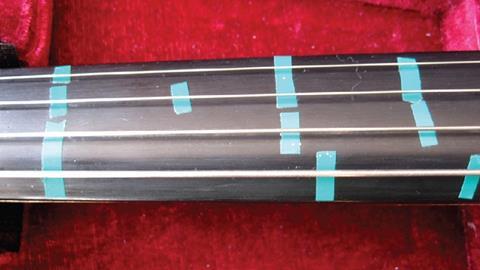Three string teachers debate the age-old question: should stickers be used on the fingerboard when teaching a beginner pupil?

The dilemma New string teachers often find themselves conflicted with regard to the use of stickers on the fingerboard. Many swear by them, insisting that their young pupils need some guidance as to where the notes lie, at least up until ABRSM Grade 1. On the other hand, it creates a discouraging leap in difficulty when the stickers come off and pupils are told to ‘listen’ instead. We asked three experienced teachers their opinion
BRENDA BRENNER

I believe that using stickers, or tape, at the beginner level is much more helpful than harmful. For violin and viola students, I always use tape at the very start. Many teachers in the US buy auto-detailing tape from auto parts stores to mark their students’ instruments. This tape is the correct width and doesn’t leave a gummy residue on the fingerboard when removed. Alternatively, one can cut thin slivers of brightly coloured plastic tape to contrast with the black fingerboard.
One issue with using tapes is that with practice (and sweaty little fingers) they move. Often I have found myself in a situation where the child plays with fingers on the tapes and believes that this means they are in tune, whether the tape is correct or not. So it is imperative for the teacher to do a lot of aural training at the beginner level.
I have found singing to be very helpful, as this ensures that students are able to ‘hear’ the music prior to playing on their instrument. Matching octaves (open strings to third fingers for the upper strings) and listening for the resonance of the instrument when it is played in tune are important skills to develop from the beginning.
I start to remove the tapes as soon as the student begins to adjust and recognise correct pitch while playing. This will be a faster process for some students than for others. If I were teaching a pupil who lost interest without stickers, I would make it a more gradual process so that the student felt secure and confident. Perhaps just removing one tape at a time would be sufficient for that process to be more successful.
Brenda Brenner is associate professor of music education at Indiana University Jacobs School of Music, and assistant director of the IU String Academy.
WILLIAM BRUCE

Will giving a student an initial visual and tactile association with pitch on a stringed instrument slow down the development of their tuning skills, or could it help the brain to link and relate pitch more securely within its executive functions? It is surprising how well-developed even a four-year-old’s ear actually is. Many of them can differentiate between fractions of a semitone, way beyond the precision that a sticker on the fingerboard can give. So why is it so difficult for a beginner student to play in tune?
If you were to give an international opera singer a violin, or ask any string teacher to play their instrument with the bow in the left hand while fingering in the right hand, and just listen! Imagine the years it would take them to get a three-octave scale in tune. Without the development of their fine motor skills, connections can’t follow through no matter how acute the ear. This takes a long time and success rests on the technical set-up.
Good technique has evolved over the centuries not only because it is the most efficient way of playing but also because it avoids damaging the body. The finest teachers of beginners I’ve seen have one thing in common – they spend a huge amount of the journey setting up the hand shapes in an imaginative and fun way.
They focus on the ‘how’ and not the ‘what’. Faults can easily become reinforced, and emotions firmly associated. It then takes an age to un-learn them at some point in the future. It’s so much easier for the ear to guide the fingers if the left hand is correctly set up. And that will make stickers redundant.
William Bruce is head of strings at the Junior Guildhall School of Music and Drama and an ABRSM examiner.
HAUKUR HANNESSON

Stickers can be a valuable tool in a string teacher’s toolbox. When to use them, however, must be a carefully thought-through decision. There are times when their use is beneficial and times when it is not.
The arguments for using or not using stickers differ between stringed instruments. For a violin or a viola teacher, using stickers can be an integral part of the beginner pupil’s set-up. When holding a violin or viola, the pupil has direct visual contact with the left hand. It is therefore possible to use stickers on the fingerboard without compromising the creation of a good playing posture.
For a cello or a double bass teacher it is more problematic. Cellists mostly do not have direct visual contact with their left hand when playing (certainly not when in first position). If the pupil has to turn their head to look at the left hand and the stickers, it creates problems in establishing good posture.
I am a cello teacher and have almost never used stickers for visual identification of the left hand’s position, mainly because of the problems such use entails as regards posture. I do, however, use one sticker on the back of the fingerboard. The beginner cello pupil can then feel (but does not have to see) where the thumb is to be positioned. This has proved to be beneficial. I use stickers that will automatically fall off after some time and unless I see a strong need by the pupil to continue using the thumb sticker, I don’t replace it when it falls off. In most cases this is a painless process.
The goal for a beginner string pupil must be to play without stickers on the fingerboard. The road towards this goal, however, will be different for everyone. Strong visual learners (as opposed to strong aural learners) will develop a greater dependency on stickers as a reference for their finger position. It is, however, the role of the teacher to find the best way for each pupil to reach this goal. The path to cello mastery is necessarily different for each pupil and it is the teacher’s task to use this tool in their toolbox in a constructive way.
Haukur Hannesson is a cello teacher, teacher trainer and former chairman of the International Suzuki association
This article was first plublised as part of the 'Ask the Experts' series in the November 2016 issue of The Strad











































No comments yet